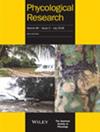Molecular assessment of Ulva (Ulvales, Chlorophyta) diversity in Vietnam including the new species U. vietnamensis
IF 1
4区 生物学
Q2 MARINE & FRESHWATER BIOLOGY
引用次数: 3
Abstract
Species diversity of Ulva in Vietnam was investigated using three commonly used genetic markers, the nuclear encoded rDNA ITS region and the plastid encoded rbcL and tufA genes. Single locus species delimitation methods, complemented with morphological and ecological information resulted in the delimitation of 19 species. This diversity is largely incongruent with the traditional understanding of Ulva diversity in Vietnam. Only four species identified in this study, U. lactuca, U. reticulata, U. spinulosa, and U. flexuosa, have been previously reported, and seven species, U. ohnoi, U. tepida, U. chaugulii, U. kraftiorum, U. meridionalis, U. limnetica, and U. aragoënsis, are recorded for the first time from Vietnam. Seven genetic clusters could not be associated with species names with certainty. A new species, U. vietnamensis, is described from marine to brackish coastal areas from southern Vietnam based on its morphological and molecular distinctiveness from the currently known Ulva species. A comparison with recent molecular‐based studies of Ulva diversity showed that species composition in Vietnam is similar to that of adjacent countries, including Japan, China, as well as Australia. Our study emphasizes the importance of molecular data in the assessment of Ulva diversity, and indicates that a lot of diversity may still remain to be discovered, especially in tropical regions.越南Ulva(Ulvales,Chlorophyta)多样性的分子评估,包括新种vietnamensis
利用核编码rDNA ITS区和质体编码rbcL和tufA基因3种常用遗传标记对越南乌尔瓦属植物的物种多样性进行了研究。采用单位点物种划分方法,结合形态学和生态学信息,共划分出19种。这种多样性在很大程度上与越南对乌尔瓦多样性的传统理解不一致。本研究中发现的4个品种(lactuca U.、reticulata U.、spinulosa U.和flexuosa U.)为先前报道的品种,7个品种(ohnoi U.、tepida U.、chauclii U.、kraftiorum U. meridionalis、U. limnetica和aragoënsis)为首次在越南发现。7个遗传簇不能确定地与物种名称联系起来。根据其形态和分子特征,描述了越南南部海域至半咸水沿海地区的一新种——越南乌尔瓦(U. vietnamensis)。与近年来基于分子的Ulva多样性研究的比较表明,越南的物种组成与邻近国家(包括日本、中国和澳大利亚)相似。我们的研究强调了分子数据在Ulva多样性评估中的重要性,并表明仍有许多多样性有待发现,特别是在热带地区。
本文章由计算机程序翻译,如有差异,请以英文原文为准。
求助全文
约1分钟内获得全文
求助全文
来源期刊

Phycological Research
生物-海洋与淡水生物学
CiteScore
3.60
自引率
13.30%
发文量
33
审稿时长
>12 weeks
期刊介绍:
Phycological Research is published by the Japanese Society of Phycology and complements the Japanese Journal of Phycology. The Journal publishes international, basic or applied, peer-reviewed research dealing with all aspects of phycology including ecology, taxonomy and phylogeny, evolution, genetics, molecular biology, biochemistry, cell biology, morphology, physiology, new techniques to facilitate the international exchange of results. All articles are peer-reviewed by at least two researchers expert in the filed of the submitted paper. Phycological Research has been credited by the International Association for Plant Taxonomy for the purpose of registration of new non-vascular plant names (including fossils).
 求助内容:
求助内容: 应助结果提醒方式:
应助结果提醒方式:


